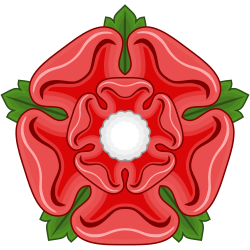Manchester City Council coat of arms

A coat of arms was granted to the Corporation of Manchester in 1842 and continue to be used today by Manchester City Council. [2] The blazon, or description of the arms, is as follows:
- Arms:Gules three Bendlets enhanced Or a Chief Argent thereon on Waves of the Sea a Ship under sail proper.
- Crest:On a Wreath of the Colours a Terrestrial Globe semée of Bees volant all proper.
- Supporters:On the dexter side a Heraldic White Hart Argent attired collared and chain reflexed over the back Or and on the sinister side a Lion guardant Or murally crowned Gules each charged on the shoulder with a rose of the last.
- Motto:Concilio et Labore
On the shield, the red field and gold stripes are derived from the coat of arms of the de Gresle family, were the first lords of the manor of Manchester. [3] They also represent the rivers Irwell, Medlock and Irk, which flow through Manchester. [4] The ship represents the city's trade, but pre-dates the opening of the Manchester Ship Canal by fifty years. [3]

On either side of the shield are a pair of supporters, an antelope and a lion, derived from the arms of King Henry IV, Duke of Lancaster, each bearing the red rose of Lancaster on its shoulder. Above the shield the crest consists of seven bees flying over a globe, symbolising Manchester's industry. Beneath the shield is the city's Latin motto, Concilio Et Labore, which is loosely translated to "by wisdom and effort" or "by counsel and labour", a phrase taken from the Book of Ecclesiasticus 37:16: "Let reason go before every enterprise, and counsel before every action". [4] [5]
The coat of arms appears on many buildings around Manchester, including Manchester Town Hall and the Corn Exchange, and on blue plaques in the city. [5] The gold bendlets on a red field are used in the arms of the Diocese of Manchester, and were used in the arms of the former University of Manchester Institute of Science and Technology, Victoria University of Manchester, and Great Central Railway to signify their link to the city. [3] The ship is used in the arms of Manchester City Football Club (which also includes the bendlets) [6] and Manchester United Football Club. [7] The University of Manchester incorporates bees in its arms, and Manchester Metropolitan University uses antelope supporters and has a crest of a lion rampant holding a globe with bees. [8] [9]

